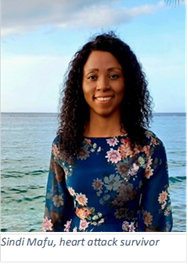
Your face goes slack, you try to speak but your words are slurred. You cannot move one side of your body. It’s happening. You’re having a stroke! CDU’s Dr. George Marks tells us more:
Stroke remains the third leading cause of death in the United States accounting for about 1 in every 18 deaths. The incidences are increasing with 795,000 new cases per year reported in the United States. Stroke is also one of the leading causes of long-term disability in the United States. The overall national 2009 direct and indirect estimate of the cost of strokes was $68.9 billion, most of which resulted from a loss of earnings due to the disability of stroke.
Nearly 75% of people who have a stroke are over 55 years of age. Stroke also kills about 130,000 Americans each year. Unfortunately, African Americans have nearly two times the risk for a first-ever stroke as Whites.
A stroke occurs when blood flow to an area in the brain is cut off depriving the brain cells of oxygen and nutrients. Within minutes, brain cells begin to die. If a stroke is not caught early, permanent brain damage or death can result.
There are two types of stroke. The more common type of stroke is an ischemic stroke. This type occurs when a blood clot travels through the blood vessel to the brain and blocks blood flow to the brain cells. Ischemic strokes also occur when too much plaque caused by cholesterol and fatty deposits clog the brain blood vessels. About 80% of all strokes are ischemic strokes.
The second type of stroke is the hemorrhagic stroke caused by the rupture or breakage of a blood vessel in the brain, with bleeding into the brain tissue, causing damage to the brain cells. The most common cause of this bleeding is high blood pressure and brain aneurysm. An aneurysm is a weakness or thinning of the blood vessel walls which can then rupture and bleed.
Symptoms of stroke include:
1. Paralysis, weakness or numbness of the face, arm or leg; especially, in one side of the body. You may experience drooping of one side of the face or mouth
2. Loss of vision or dimming (like a curtain falling) in one or both eyes
3. Loss of speech or difficulty speaking or understanding what others are saying. You may find yourself slurring your words or feeling confused
4. Sudden severe headache with no known cause
5. Loss of balance or unstable walking. You may stumble or lose coordination.
If someone you are with is experiencing any of these symptoms, you should immediately call 911. Stroke is a medical emergency. Do not wait to see if the symptoms go away. Prompt attention is crucial. Every minute counts. The longer a stroke goes untreated, the greater the likelihood of brain damage and disability. Immediate attention can save lives and increase the chances of full recovery.
According to the American Stroke Association (strokeassociation.org) about 80% of strokes can be prevented by improving diet, lifestyle and stressors. Many factors can increase the risk of stroke. Some of these risk factors can also increase the chances of having a heart attack.
Potential treatable stroke risk factors include:
Lifestyle risk factors:
a. Being overweight or obese
b. Physical inactivity
c. Heavy or binge drinking
d. Use of illicit drugs such as cocaine or methamphetamines
Medical risk factors:
a. High Blood Pressure. Incidence increases as BP increases above 120/80 mmHg
b. Cigarette smoking
c. High Cholesterol
d. Diabetes
e. Obstructive Sleep Apnea
Other factors also associated with a higher risk of stroke include:
a. Personal or family history of stroke
b. Being age 55 or older
c. Race – African Americans have a higher risk of stroke than do other races. The incidence in Hispanics falls somewhere between that in African Americans and Whites.
d. Gender – Men have a higher risk of stroke than do women. Women are usually older when they suffer a stroke. Women may also have some risk from some Birth Control Pills or hormone therapies that include Estrogen.
California, when compared with the nation, as a whole, has an average rate of stroke mortality that is slightly above the national average.
After a stroke, people can experience many changes. Some effects are physical with weakness and numbness. Other effects can be emotional with fear and apprehension. Still other effects can be difficulty recognizing things or difficulty with memory. The earlier intervention occurs with stroke the less likely it is that people have serious complications.
Dr. George Marks, lead physician, Cardiology, Martin Luther King Jr. Outpatient Center is a 30 year veteran of the Outpatient Center and Charles R. Drew University of Medicine and Science where he is an Assistant Professor and an alum. For more information about this Historically Black Graduate Institution, visit www.cdrewu.edu.





